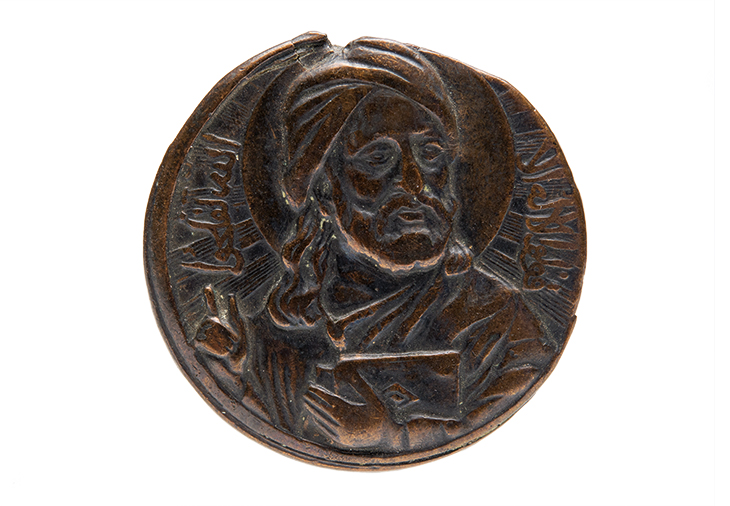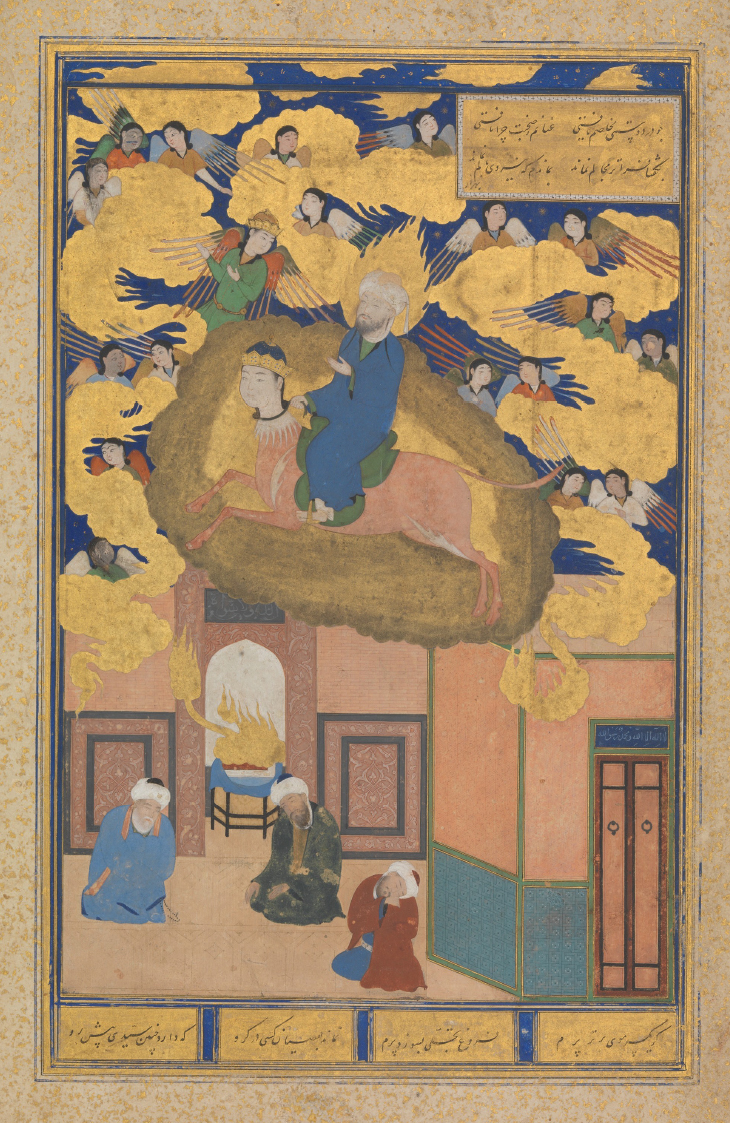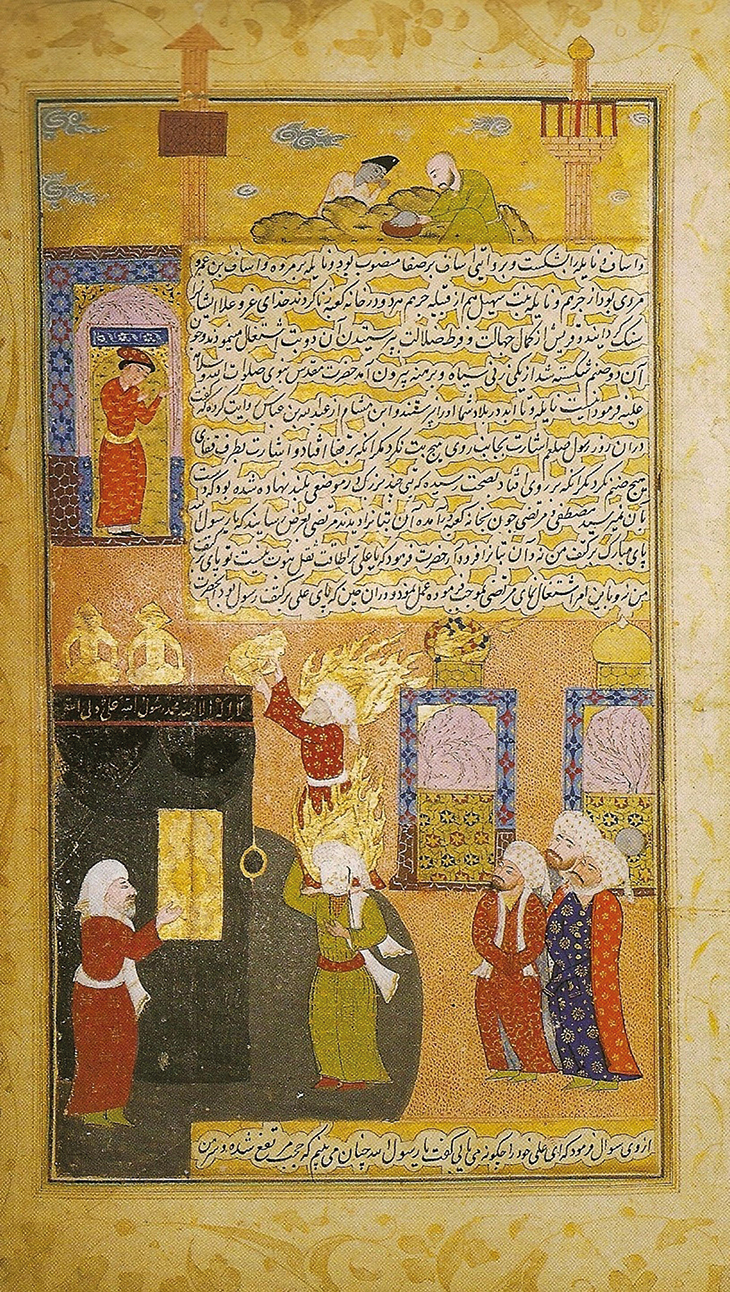From the November 2019 issue of Apollo. Preview and subscribe here.
Hidden somewhere in the Tropenmuseum in Amsterdam is a remarkable bronze medallion featuring a noble-looking man holding a book. His halo and beard make him resemble Jesus – but an Islamic invocation running round the edge indicates that this is, in fact, the Prophet Muhammad posing with a Qur’an. At the time of the purchase in 1976, the Iranian seller had insisted that it was indeed Muhammad. Yet the Tropenmuseum curator was doubtful: like many others, the curator believed Islam frowned on figurative art in general and strictly forbade images of the religion’s founder. It was put in storage. Only now, 40 years on, after comparing it with 19th-century paintings of the Prophet, does the Tropenmuseum acknowledge the seller’s veracity.
Medallion with portrait of the Prophet Muhammad (n.d.), south-west or central Asia. Courtesy Nationaal Museum van Wereldculturen, Amsterdam

The slow recognition of the existence of such images has not been helped by recent controversies. Since the 2006 protests against Danish newspaper Jyllands-Posten and the murderous attack on French magazine Charlie Hebdo in 2015, both of which had printed caricatures of the Prophet, curators have become increasingly anxious about what might be lurking in their collections. For Islamic visualisations of the Prophet are surprisingly common, especially in the richly illustrated books made in Persian and Ottoman courts, both Sunni and Shia, between 1300 and 1800. In the Ilkhanid vizier Rashid ad-Din’s world history of 1314, there are some fascinating early examples. But when the University of Edinburgh displayed its folios in 2014, images of the Prophet were mysteriously missing. In the febrile post-Charlie Hebdo atmosphere, the Victoria and Albert Museum even expunged from its online database an Iranian poster of a youthful Muhammad. A spokeswoman claimed that ‘our security team made the decision’.
Stefano Carboni, until July the director of the Art Gallery of Western Australia, Perth, has been trying to put together an exhibition to run in parallel with a valuable new collection of essays, The Image Debate: Figural Representation in Islam and Across the World (Gingko). Carboni tells me by email that a number of Australian, Asian and US institutions did not commit to the project for the ‘perceived risk as to how sections of the exhibition, including images of the Prophet Muhammad, would be received in particular by Muslim communities’.
It’s still a common assumption that since Islam is essentially iconoclastic, any figurative images of the Prophet – even if created by Muslims – will provoke violence. Such works therefore have either to be explained away – it’s not really him – or kept hidden from the general public.
Thankfully, this kind of doublethink is now being questioned. The foremost expert on the subject is Christiane Gruber, a professor of Islamic art at the University of Michigan. Her recent book The Praiseworthy One: The Prophet Muhammad in Islamic Texts and Images (Indiana University Press) is the first of its kind. (She also edited The Image Debate.) When I meet her in London in June, she tells me that curators ought to be bolder. ‘To my knowledge,’ she says, ‘there have never been any violent or negative reactions to public displays of Muhammad in museums.’ Indeed, Gruber believes that curators who close their eyes to this figurative tradition only strengthen the fundamentalists: ‘That’s the kind of Orientalist-Salafi echo chamber […] that I think is very detrimental to the heritage of Islam.’
The problem partly comes down to a confusion of categories. The Charlie Hebdo cartoons did not provoke anger because they portrayed the Prophet – rather it was their deliberate offensiveness. Such mockery is deep-rooted in Western culture. In medieval Europe, the Prophet was a stock figure of ridicule. John Tolan’s new book Faces of Muhammad (Princeton University Press) reprints a grisly illustration from a 15th-century manuscript of John Lydgate’s long poem The Fall of Princes, in which the ‘false Machomeete’ is ‘deuoured among swyn’. In a post-9/11 world, provocative images of the Prophet were reactivated, not only to attack the religion but also to taunt Muslim minorities living in the West.
We live, unavoidably, in what Gruber calls a ‘post-cartoon’ world. But we can at least try to lose some of our modern cultural baggage. ‘What if we were to backtrack 30 years, backtrack to the 16th century?’ she asks me. ‘How do we put ourselves into that?’ Notably, she doesn’t reproduce any satirical images in The Praiseworthy One, or the essay collection. For a more nuanced historical analysis we need to forget about modern issues such as free speech and terrorism, and to imagine ourselves into the milieu of Muslim artists and patrons who honoured the Prophet through painting.
Visit a church and you will see Christ, but Muhammad never appears in a mosque. The Qur’an accuses Christians of wrongly deifying Jesus, and pointedly describes the Prophet as a ‘mere warner’. Idol-worship is also a concern. But nowhere does the Qur’an ban figurative painting; in fact, in verses quoted by later Muslim artists, Jesus moulds a clay bird with his hands before breathing life into it. Later biographical stories about the Prophet send mixed messages. After conquering Mecca, he removes pagan statues from the sacred Kaaba – but saves an icon of Mary and Jesus. He chides his wife Aisha for putting up curtains decorated with animals; other versions of the story, though, say he didn’t mind her turning the curtains into cushion covers.
Formal disapproval of image-making – though never universally enforced – is not recorded until two centuries after the Prophet’s death in 632. The art historian Mika Natif argues these rulings solidified in the Abbasid era as a way of rebuking its predecessor dynasty the Umayyads, whose delight in portraiture was deemed symptomatic of its decadence. The Abbasids might have had a point. The walls of the Greek-influenced Umayyad bathhouse at Qasr Amra, in what is now Jordan, are covered with enrobed kings, naked women and performing animals – my personal favourite is a bear playing a mandolin.
Bears in the caliph’s private retreat are one thing; public images of the Prophet quite another. Yet Islam’s founder may have appeared on Umayyad coins within 60 years of his death. In the 690s, the caliph Abdel Malik minted gold dinars portraying a standing figure with a long beard, holding a sword. (There’s one in the British Museum.) For a long time, it was assumed this was a semblance of the caliph himself. But recent comparisons with contemporaneous Byzantine coins showing a bearded Jesus are changing the consensus. And a similar standing figure on a copper coin has the name ‘Muhammad’ clearly written down the side. These are not, most likely, portraits from life. Instead they encapsulate a model of leadership – the intimidating warrior-prophet – popular during the Islamic conquests. So even if it is the Prophet, it is still just as much the caliph.
Such coins soon faded from fashion, and there are no surviving images of the Prophet for the next five centuries or so. He re-emerges, unusually, in a work that isn’t actually about him. At the finale of the Persian romance Varqa and Gulshah, the story is given a religious gloss when the star-crossed lovers are miraculously resurrected by the Prophet. One Seljuk manuscript of the tale made in Konya, Central Anatolia, between 1200 and 1250 shows Muhammad sitting cross-legged on a green throne attended by his four successor caliphs. With his Turkic features and long black tresses, this is definitely a Seljuk-style kingly prophet. He is even more grandly enthroned in the prologue to a 14th-century edition of Ferdowsi’s epic poem Shahnameh, in which he is imagined as the ideal prototype for the ancient Persian kings whose reigns the poem describes.
‘The Miraj or The Night Flight of Muhammad on his Steed Buraq’ (c. 1525–35), probably Bukhara, miniature from a 1514 copy of Bustan of Sadi. Courtesy Metropolitan Museum of Art, New York

One incredibly popular subject for illustration was the ascension narrative or Miraj-nameh. Originating in a few short Qur’anic verses, the narrative was elaborated into a vivid adventure. The Prophet rides on a flying horse called Buraq through the heavens, where he leads his fellow prophets in prayer and converses with God. This magical tale accommodated pre-Islamic iconography. Two Timurid ascension books made in 15th-century Herat feature a white rooster angel who crows the profession of faith across the celestial realm, and a half-fire, half-snow Buddha-like angel. Muhammad encounters God amid swirling golden clouds. Prostrate in prayer, the Prophet cannot look on his fiery glory. Neither can the viewer: God is never visually portrayed in Islam.
Responding to this illustration, the contemporary Iranian artist Shahpour Pouyan reproduces the page from the 1436–37 Timurid ascension book, but blanks out both Prophet and divine radiance. All that’s left is a deep blue rectangle – an enigmatic comment on modern Muslim attitudes to visualising the Prophet.
By late medieval times, in both Sunni and Shia works, it had become unfashionable to show the Prophet’s face – in one famous Ottoman biography commissioned by Murad III, even the infant Muhammad’s face is covered. Concerns over idol-worship remained. A 16th-century Persian manuscript made in Shiraz shows a veiled Muhammad and his son-in-law Ali, on his shoulders, removing monkey-shaped idols from the Kaaba. Yet this isn’t a simple reversion to iconoclasm. Notice that the destruction of images is itself being celebrated with an image. The Prophet’s own (intact) veil is inscribed with ‘Oh Muhammad’ in gold ink. If you look closely enough at the name, though, a cubist-like face emerges – the two letters mim resemble eyes, the ha a nose and the dal a mouth. Was this a puzzle pictogram requiring the viewer to use their own imagination? And while Ali’s face has been damaged, this could be down to devotional rubbing, kissing or perhaps licking.
‘The breaking of the idols at the Kaaba’, miniature from a copy of Mirhkwand’s Rawdat al-Safa (c. 1585–95), Shiraz. Museum für Islamische Kunst, Berlin

‘We need to make way for the affect, the emotion of love,’ Gruber stresses to me, ‘as opposed simply to hate or aversion.’ Sufis, for example, emphasise their intimacy with the Prophet. In an exquisite Bukharan miniature made in the 1530s, three Sufis conjure him in their minds. A nearby Qur’an bursts into a flame that ignites an image of Muhammad on Buraq. The artist is imagining the Sufis imagining the Prophet as a real presence, his gentle features offering the perfect model for a loving mystic.
Warrior, king, celestial adventurer and Sufi – these are just four popular Muhammads. Nowadays you are most likely to see abstract representations such as an imprint of his sandal or a rose. These depictions, we should note, are no less meaningful for being non-figural. One curator of Islamic art at a private collection in London, who wants to remain anonymous, tells me that the framing of Gruber’s project to ‘restore to Islam its rich artistic heritage’, as the blurb to The Praiseworthy One has it, is problematic. ‘Everyone knows how crucial Muhammad is to Muslims […] and Islam doesn’t need its culture restored to it.’ Gruber acknowledges the objections. ‘It’s not about the images being taken away, and then given back to Muslims,’ she tells me. ‘It’s about restoring the proper discourse around images in a way that is free from other kinds of agendas.’
That can only happen, of course, if we can see the images in their proper context – not on the anti-Muslim websites where they often cluster. Fortunately, things are changing. The Rietberg Museum in Zurich is organising a show in autumn 2020 about iconoclasm and iconography in which images of the Prophet will be included. Stefano Carboni’s delayed exhibition is, he tells me, ‘almost certainly going to be held in a North American institution’ next year. At Frieze Masters this October, Francesca Galloway was selling a folio from the 1460s Timurid illustrated ascension; Christie’s had two from the same work up for auction in the same month. Some Muslims will never want to see their Prophet pictured. That is their right. But we can’t pretend that such images never existed. Scholars and curators must play their part in allowing Muslims and others to speak to each other across time about the diverse ways the Prophet has been regarded. For this world-changing personality has always been in the eye of the beholder.
From the November 2019 issue of Apollo. Preview and subscribe here.


